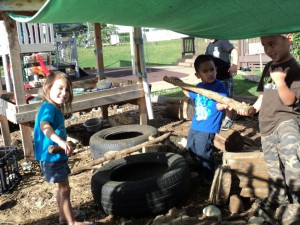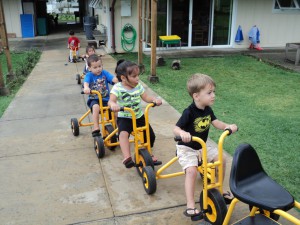Today was our Wheeled Toys Day. Even though it rained in the morning, we were able to ride in the breezeway until the weather allowed us to go up the Waipao playground. The children are all at different developmental stages of bike riding. Typically, by the end of their third year, children should have mastered a three-wheeler with few accidents. When they turn four years old, children can turn corners and steer out of the way of objects and peers. Four year old children can also pedal and steer a two-wheeled bike with training wheels. Keep practicing at home!

Monthly Archives: February 2013
Thursday, February 21, 2013
Today, because of the rain, we were unable to go to outdoor play. We are sure that you are well aware that children need to keep active. So, keeping children indoors for the entire school day can be difficult. Today, we played indoor beach ball volley ball. We used a blown-up beach ball instead of a hard volleyball. The lighter ball has a much greater hang time, making it easier for younger children to set up to hit the ball. The children worked with a partner. We used two shelves as the “net”. It kept them busy and engaged for almost 30 minutes.
Wednesday, February 20, 2013
Today during outdoor play, the children enjoyed riding their tricycle through the “car wash.” It was one child’s idea to get the large orange fabric and stretch it across the bike path. First, two people held up each end. Then, several children problem solved and asked us to tie the fabric to the pole and to the railing of the deck. As three year olds engage in role-playing, they come to understand their own life experiences and their growing awareness of their community.
Tuesday, February 19, 2013
The new toys in the Block Center are plastic zoo animals of different sizes. Today, children used the bocks to build an enclosure for the animals. When children are building with blocks they learn about sizes, shapes, amounts, and why it’s important to build a sturdy base. They do this by counting blocks, discovering which ones are the same shapes, and learning the names of the different shapes. The children learn to share and develop their language skills as they play together and talk about their blocks structures. 
Friday, February 15, 2013
This week we have been reading books that count up to 10. Our song of the week was “One Little, Two Little, Three Little Valentines……” The children took turns being a number holder or a number pointer. Preschool programs should provide children with opportunities to learn about numbers, numerical representation, and simple numerical operations. Some things a child does to demonstrate competency are to use counting and numbers as part of play, recognize and name some number symbols count up to 10 objects, demonstrate the idea of adding and subtracting using fingers or objects. 
Thursday, February 14, 2013
Today in the Messy Materials Area, children were observed “cooking a pig.” In this picture, two boys pretend to carry a pig on the stick. Other children joined in to help put sticks and other materials on to the fire. As we observed them, it was very obvious that some of them have had first-hand experience of preparing and cooking a pig for an imu. When children share background knowledge and experiences with their peers or teachers, it is a way for them to connect home and school. Children acquire understanding of the world around them from personal experiences. They learn about human interdependence and the relationships between people and their environment. Educators use the words “Social Studies” to label this kind of social and cultural learning and understanding.
Wednesday, February 13, 2013
Our Shoe Store is evolving into a Dress-Up Party. We added fancy dresses, more shoes, black coats, and jewelry. To prevent boredom, we change Dramatic Play area periodically. We also change it to accommodate the children’s emerging interests. When you develop something inspired by the children’s emerging interest, you create a captivating environment where children learn and discover by participating in activities they enjoy. 
Friday, February 8, 2013
Gung Hee Fat Choy! The children celebrated Chinese New Year today with a snack of manapua and noodles and a Chinese Lion Dance (parade) around the school. Each child made their own Chinese Lion head using a cardboard box and collage materials. Each child received a red envelope for their dance. Traditionally, when there is a lion dance, people give red envelopes. Lai see is the Cantonese name for the red envelopes. Hong bao is the Mandarin name for it. (This is a correction from the parent note that I sent home yesterday.) Happy Chinese New Year.
Thursday, February 7, 2013
Music and movement are an important aspect of any early childhood curriculum. Today, we revisited scarf dancing. This time, the children were able to choose two scarves from the pile. To introduce scarves, we usually start with a little game with simple instructions. We encourage the children to hold one corner and wiggle your scarf, scrunch it into a ball, hold it by two corners to make a square and flap it around line sheets on a clothesline, and tie it around your neck like a super hero. The best encouragement for children to dance is for adult to dance as well. We certainly do! Try scarf dancing at home with your child. You can rummage through your wardrobe for silky, lightweight chiffon items. The secret is to find lightweight and sheer.
Wednesday, February 6, 2013
Three year olds enjoy repeating physical activities over and over, such as sliding, jumping, and riding a trike. Three-wheeled toys such as trikes are a favorite of three year olds. They can master them easily if the trike is appropriately sized. We have a variety of trike sizes to choose from. At age four, preschoolers have fewer accidents, can turn corners and steer out of the way of objects and peers. This was our week to take the trikes to the playground. We challenged the children by having them pedal up the incline leading to Waipao, our playground. Large motor activities are an important part of your child’s day in preschool. It helps them develop good self-esteem and physical competence. 
